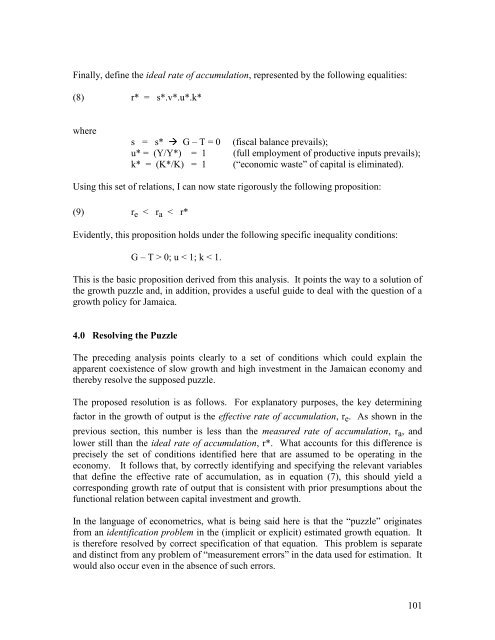PIOJ Growth-Inducement Strategy - Planning Institute of Jamaica
PIOJ Growth-Inducement Strategy - Planning Institute of Jamaica
PIOJ Growth-Inducement Strategy - Planning Institute of Jamaica
Create successful ePaper yourself
Turn your PDF publications into a flip-book with our unique Google optimized e-Paper software.
Finally, define the ideal rate <strong>of</strong> accumulation, represented by the following equalities:<br />
(8) r* = s*.v*.u*.k*<br />
where<br />
s = s* G – T = 0 (fiscal balance prevails);<br />
u* = (Y/Y*) = 1 (full employment <strong>of</strong> productive inputs prevails);<br />
k* = (K*/K) = 1 (“economic waste” <strong>of</strong> capital is eliminated).<br />
Using this set <strong>of</strong> relations, I can now state rigorously the following proposition:<br />
(9) r e < r a < r*<br />
Evidently, this proposition holds under the following specific inequality conditions:<br />
G – T > 0; u < 1; k < 1.<br />
This is the basic proposition derived from this analysis. It points the way to a solution <strong>of</strong><br />
the growth puzzle and, in addition, provides a useful guide to deal with the question <strong>of</strong> a<br />
growth policy for <strong>Jamaica</strong>.<br />
4.0 Resolving the Puzzle<br />
The preceding analysis points clearly to a set <strong>of</strong> conditions which could explain the<br />
apparent coexistence <strong>of</strong> slow growth and high investment in the <strong>Jamaica</strong>n economy and<br />
thereby resolve the supposed puzzle.<br />
The proposed resolution is as follows. For explanatory purposes, the key determining<br />
factor in the growth <strong>of</strong> output is the effective rate <strong>of</strong> accumulation, r e . As shown in the<br />
previous section, this number is less than the measured rate <strong>of</strong> accumulation, r a , and<br />
lower still than the ideal rate <strong>of</strong> accumulation, r*. What accounts for this difference is<br />
precisely the set <strong>of</strong> conditions identified here that are assumed to be operating in the<br />
economy. It follows that, by correctly identifying and specifying the relevant variables<br />
that define the effective rate <strong>of</strong> accumulation, as in equation (7), this should yield a<br />
corresponding growth rate <strong>of</strong> output that is consistent with prior presumptions about the<br />
functional relation between capital investment and growth.<br />
In the language <strong>of</strong> econometrics, what is being said here is that the “puzzle” originates<br />
from an identification problem in the (implicit or explicit) estimated growth equation. It<br />
is therefore resolved by correct specification <strong>of</strong> that equation. This problem is separate<br />
and distinct from any problem <strong>of</strong> “measurement errors” in the data used for estimation. It<br />
would also occur even in the absence <strong>of</strong> such errors.<br />
101
















